NEONATOLOGY ON THE WEB
The Nursling
Lecture 8
By Pierre Budin, Professor of Obstetrics, University of Paris; Director
of the Clinique Tarnier; Member of the Academy of Medicine, Paris, France. Authorized
translation by William J. Maloney, M.B., Ch. B., 1907.
Gentlemen,
We had discussed the qualities and sterilisation of cows' milk,
and the value of observation and weighing in the regulation of an
infant's diet, and I was demonstrating to you that the balance was
indispensable as a guide in mixed feeding. I now wish to cite a few
more cases which emphasise this important point.
A woman named Lud_____ was delivered in the Maternité on
March 15, 1896. She was in feeble health, and during a previous
lactation I had had considerable anxiety on her account. She was very
eager to suckle, and, although she had not much milk, I allowed her
to do so. The infant weighed 3050 grams at birth. As on March 28 he
was only 2950 grams, I added 200 grams of sterilised milk to his
daily ration (Fig. 92). On April 11 he
reached 3420 grams, but, owing to the strain on the mother, I
increased his cows' milk to 250 grams. His curve soon regained the
normal. On May 31 his allowance was raised to 375 grams. On July 25 I
learned from the mother that during the last few days her milk supply
had greatly diminished. The hungry child had cried incessantly, and
she, not wishing to inconvenience me by coming on any but the day set
apart for the Consultation, had given the child some milk, previously
boiled, in addition to what I had prescribed. I raised the 375 grams
to 600, and the curve continued to rise steadily until November 21,
when the infant was found to have lost 160 grams within a fortnight.
As, in the absence of all pathological phenomena, this loss could
arise only from underfeeding, his allowance was increased to 700
grams, and, on this not proving quite sufficient, to 800 grams, from
November 28. By January 30, 1897, the mother's milk had practically
disappeared. The infant weighed 10,200 grams, and was getting 1000
grams of milk per day. This amount had to be increased on February 27
to 1200 grams, but on the whole his curve is excellent, and, indeed,
quite above the average.
A woman named Men____, after the usual ten days' stay, left the
hospital on October 22, 1897, when her infant weighed 4700 grams; as
on her first appearance at the Consultation on November 27 he was
only 5320 grams, the average gain per day had not exceeded 19 grams.
She told me that, not having enough milk for the child, she had been
giving him cows' milk in addition to the breast-feeds. I prescribed
100 grams of sterilised milk, and the infant increased steadily
(Fig. 93). On January 8 the menses
reappeared, and the child lost weight slightly. I gave 150 grams per
day, and on the 12th raised this amount to 200. Again I had to
augment the supply; on February 1 I made it 375 grams, but this did
not long remain sufficient. On February 26, 450 grams were required;
on November 5, 600; and on March 8, 700. On April 9, 1898, the
mother's supply having finally ceased, the nursling was given a daily
allowance of 800 grams, which, on April 16, was raised to 900. A
little farinaceous food
was added on June 10. On September 2 he weighed 8950 grams; as on the
9th and 16th he had lost 60 and 170 grams respectively, I increased
his sterilised milk to 1000 grams. Immediately he began to gain, and
on November 4, although barely thirteen months old, scaled 10,120
grams. A subsequent lactation in this woman followed the same course.
Every Wednesday a woman brings her little grandson, Su_____, to
the Consultation. He was born here on September 10, 1898. Breast-fed
by his mother, he weighed 4500 grams on September 30, having gained
600 grams since birth. The mother, being unmarried and poor, had to
work to live. The grandmother brought the child to me on October 7,
and begged a little sterilised milk. I refused, for I make it a rule
to insist, whenever possible, on breast-feeding, and, moreover, I
object to children being brought to the Consultation by any but their
mothers. "But," pleaded the grandmother, "we must live, so my
daughter must work. Her employer allows her to leave the factory only
at meal-times. She suckles her child then. What would you have us do?
We are too poor to give the little one a nurse." "If I give you cows'
milk," I said, "how long will your daughter be able to suckle? Her
milk will soon disappear, and the child will be exposed to all the
risks of artificial feeding." "I assure you," replied the old woman,
"that my daughter will give the child every drop of milk she can
produce. If you do not grant me the milk we shall have to buy it, and
not only will this be a great burden to us, but, further, any milk we
can obtain will probably be inferior to that which you distribute.
Give me the milk, sir, and you will see how well the little one will
be cared for." Needless to say, gentlemen, I gave way. On October 7 I
gave 200 grams of sterilised milk per day; on the 28th, 250; on
November 18, 300; on November 25, 350; on December 9, 400; on
February 3, 450; and on April 28, the mother's supply having
altogether ceased, 675 grams. On May 12 the infant weighed 7210
grams. We had ended, as I had feared, with artificial feeding, but
the infant had reached seven months, and was of more than average
weight for his age (Fig. 94).
Mothers who live in the whirl of modern society life, eager though
they may be to suckle their children, are often incapable of nursing,
because they produce but little milk. A wet-nurse was formerly their
only resource, but, nowadays, sterilised milk may be used to make
good their deficiency. I could cite to you many cases in which I have
used it to supplement the scanty supply of such mothers. They are
very grateful for its help, since it not only spares them the worry
of a wet-nurse -- in itself a no uncertain blessing -- but also the
mortification of having their children suckled by a stranger.
There are other ladies again who, in spite of their desire to
nurse, feel that they have obligations beyond their domestic circle
which they are in duty bound to fulfil. They replace their
breast-feeds, during that portion of the day when they go to pay
their social tax, by one or more bottles of sterilised milk. Such
mothers are often excellent nurses; their children thrive, and, when
the time comes for weaning, this mode of feeding is found greatly to
simplify the process.
Mixed feeding is an inestimable boon to mothers of twins, for they
can rarely provide enough to satisfy the needs of both. Let me give
you two out of my many cases.
A frail and miserable-looking woman, named G____, was delivered of
twins, a boy and a girl, on January 27, 1893. The boy weighed 3800
and the girl 3420 grams, when they left hospital
(Fig. 95). The mother was then
receiving 300 grams of sterilised milk with which to complete their
feeding. This amount had to be increased from time to time -- on
February 10 to 400 grams, March 10 to 600, and March 31 to 1200. The
mother's milk having ceased on June 30, the feeding became entirely
artificial. Although they lived in a small, squalid, overcrowded
room, the infants continued to thrive. Their progress was arrested
for a time by an attack of bronchitis at the end of December, but on
March 9 the boy weighed 9940 and the girl 9040 grams.
A son and a daughter were born to a woman named L_____, on
December 10, 1892. When they left hospital on December 22, the girl
weighed 3080 and the boy 2900 grams (Fig.
96). They were brought to the Consultation on December 30,
weighing 3380 and 3090 grams respectively. As they lived far from the
hospital, I gave the mother a steriliser, so that she might prepare
the children's milk at home. The mother lavished great care on them,
and they throve. But on July 1, 1893, having some business to do, she
entrusted them for the day to a friendly neighbour; on the next day
both had diarrhoea, and in less than twenty-four hours the girl lost
600 and the boy 370 grams. Happily they recovered, and on January 5,
1894, weighed 9800 and 9300 grams respectively.
I shall not repeat what I have already told you relative to the
rearing of the children of the wet-nurses at the Maternité.
Here, at the Clinique Tarnier and in many similar institutions, the
same plan is successfully followed. [1]
In our statute books there is an excellent measure for the
protection of infant life, known as "Roussel's Law." Among many
admirable clauses there is one which prohibits mothers from suckling
any but their own infant till it shall have completed the age of
seven months. There are many more mothers than good nurses, and it
seems to me that by this clause an undesirable restriction is placed
upon breast-feeding. In one case which came under my notice a
wet-nurse was threatened with legal proceedings for suckling a
nursling when her own child was not seven months old. The nursling
was then returned to its parents, and they, despairing of finding a
wet-nurse whose milk was not what they called "too old," fed it on
the bottle, and it died of diarrhoea.
I think that a mother who has suckled her child for several months
might, if authorised by her medical attendant, introduce in gradually
increasing quantities sterilised milk into its diet. She could thus
divert, without prejudice to her offspring, a portion of her milk to
another nursling, and the two, carefully supervised, would steadily
thrive. Perhaps, after a few months, even a third might be added. The
first nursling, like the wet-nurse's own child, could be put on mixed
feeding, and the new-comer given the breast exclusively.
A good wet-nurse, under medical supervision, might thus steer
several children through the dangers of early infancy and launch them
in safety upon mixed and artificial feeding. By this means the
scarcity of good wet-nurses could be counterbalanced, and full
advantage taken of the few at our disposal.
Artificial feeding, the rearing of a child exclusively on animal
milk, is sometimes, unfortunately, a necessity from birth, for some
infants have congenital abnormalities which prevent suckling; others
persistently refuse to take the breast; and others again seem to be
unable to digest human milk. It may be that the mother cannot suckle;
in some, the nipples are represented only by depressions on the
summits of the mammary glands; in others, ill-health contra-indicates
nursing; while others, attacked by acute infectious diseases, are
forced to wean. The choice then lies between a wet-nurse and
artificial feeding. The results obtained from careful artificial
feeding are excellent, and many practitioners prefer it to confiding
the child to a stranger, or introducing an element of potential
disturbance into a peaceful household.
In July 1892 a country doctor, one of my old pupils, called me to
see his wife, who, he thought, was about to develop puerperal fever.
On my arrival I was happily able to reassure him, for the alarming
rise of temperature was due to a simple mastitis. The mother,
however, had absolutely no milk, so attempts were made to procure a
wet-nurse, and I advised, in the meantime, the use of sterilised
milk. The country was scoured in a vain search for a wet-nurse, till
the parents, reconciling themselves to the inevitable, settled down
to rear the child on animal milk. At birth the child weighed 3000
grams. On November 23, at the age of five months, she was 8250 grams
(Fig. 97), and the proud father wrote
to me that she was without exception the strongest and healthiest
child he had ever seen, and he felt absolute security in her mode of
feeding.
When one or both parents are syphilitic and the mother has no
milk, artificial feeding must be adopted. You have no option. You
must not expose a wet-nurse to the risk of suckling in such a case.
Let me cite to you two typical instances.
After several pregnancies productive of dead fetuses Dr. X_____
and his wife were suspected of syphilis and treated accordingly. A
living daughter was born to them in September 1892. She weighed 3550
grams, and during the first fortnight gained on an average 26 grams
per day. An ulcerative eruption appeared on the child in the third
week, but it was not a typical syphilide. The mother had practically
no milk, but, in spite of the father's entreaties, I refused to take
the responsibility of recommending a wet-nurse; the child was
therefore fed on sterilised milk. She made very satisfactory
progress, and her curve was above the average. On December 14, 1892,
she weighed 5250 grams, and on July 6, 1893, had reached 8780
(Fig. 98).
M___ C____ had syphilis, and his wife aborted several times. He
was given mercury. His wife conceived; she was put on anti-syphilitic
treatment, and on July 5, 1893, gave birth to a full-term, living,
and healthy son weighing 3150 grams. As the mother's supply soon
became insufficient for his needs, sterilised milk was prescribed. On
August 16 he weighed 4480 grams; on November 15, 7560, and on January
15, when the mother's milk finally disappeared, 9200 grams. He never
presented any specific lesion, and his curve was excellent
(Fig. 99).
I have had many similar cases, and Professor Fournier, the eminent
authority on this subject, has published some interesting
observations, in which he also emphasizes the inestimable advantage
of artificial feeding for these tainted infants.
Should cows' milk be given undiluted? It is generally supposed to
be harmful to infants, owing to the excess of casein it contains
compared with the human product. To counteract this defect great
quantities of water are usually added to the milk. The dilution
varies with age: at first, three parts of water are added to one of
milk, then two; then equal parts of each are used, then two of milk
and one of water, and so on to the fifth or sixth month, when
undiluted milk is reached. But casein is not the sole constituent of
milk. It contains also butter, sugar, and salts, all of which
materially contribute to its value as a food. Diluted cows' milk is
generally deficient in these substances, and therefore forms but a
poor substitute for a mothers' milk. To obtain sufficient nourishment
on this attenuated diet infants are obliged to absorb great
quantities of fluid, which causes them to pass a large amount of
urine. They are almost always crying from hunger, whereas infants on
undiluted milk wait contentedly for their next meal.
An infant, one of twins, was first fed on undiluted sterilised
milk; from the second day the increase was on an average 21.6 grams
per day (Fig. 100). Then one-third of
its bulk of water was added to the milk; during the next five days he
gained only 6 grams per day. Once more he was given pure milk, and he
increased normally again. The diet of the other twin was varied in
the same way with a similar result.
Another infant, who was born on August 22, 1893, weighing 2485
grams, and who was being artificially fed, was brought to me on
December 8, 1893, because his rate of growth was very slow. As his
weight was 4300 grams, he had increased by only 18 grams per day. He
was receiving diluted milk, but on placing him upon pure milk, his
daily average increase rose to 30 grams. On February 18 he weighed
6480 grams. The second part of his curve compared with the first
affords a striking demonstration of the relative values of pure and
of diluted cows' milk as foods for infants
(Fig. 101).
One day an engineer entered my consulting room. "I am bringing to
you," said he, "my child one month old. He is in the next room with
my wife, but I want to tell you beforehand that I have had syphilis,
and that my wife, without her knowledge, was treated for that
complaint during her pregnancy. Our child was born at full term, but
he has had to be fed on cows' milk, as my wife could not suckle and I
did not wish to bring in a wet-nurse. He weighed 3000 grams at birth
and has not gained since. I am afraid that he also is infected, and I
have come to see if you can do anything for him."
I examined the child; he was wizened, wrinkled, and puny, but he
showed no trace of specific disease.
"How much milk do you give him?" I asked.
"Half a litre per day."
"Half a litre of undiluted milk?"
"No! he is but newly born. I give him two parts of water and one
of milk."
"Come, sir, you are an engineer and accustomed to calculate. Let
us reckon this up. The child gets 500 grams of liquid per day. Now,
if you are using good milk, each litre will contain 870 parts of
water and 130 of solids, consisting roughly of 40 parts of butter, 50
of sugar, and 40 of casein and salts.
"Now, if you add two parts of water to one of milk, a litre of the
mixture will contain one-third of the normal amount of solids; 130 /
3 = 43.3 grams.
"Your infant takes only half a litre of this mixture, so it gets
half of 43.3 grams, i.e. 21.65 grams of nutritive matter per
day. The child is suffering from starvation."
Thenceforth the infant received 500 grams of pure sterilised milk.
At the end of one week he had gained 200 grams, and he continued to
thrive to his parents' entire satisfaction.
Obviously, when an animal takes animal milk of poor quality it has
to absorb large quantities. Some specimens of asses' milk sold in
Paris contain very little nourishment. On November 7, 1899, I
attended at the birth of a child, Jean X____, who weighed 3120 grams.
As he had a hare lip he could not suck, and was fed artificially. I
began by giving him asses' milk. Although he took 450, 500, 600, 650,
and then 735 grams per day, his curve did not rise as well as I
desired (Fig. 102). Twice I analysed
this milk; the first time I found 9 and the second 11 grams of butter
per litre. From November 20 I substituted 50 grams of cows' milk at
one feed each day. On the tracing the asses' milk is represented in
blue, the cows' milk in red. Observe how the blue column descends
from day to day while the red one rises. By November 28, cows' milk
alone was being given, and the curve continued to rise steadily,
although only 450 grams were being ingested instead of 735. The bulk
of the infant's diet had thus been reduced by 285 grams, and yet he
was not underfed, as the cows' milk contained 40 grams of butter per
litre, whereas the asses' milk had only 9 to 11 grams.
It is alleged that the casein of cows' milk forms large clots in
the stomach and gives rise to digestive troubles. This is obviated if
the milk be heated in a steriliser at a temperature of about
100° C. "According to my experiments in vitro," says
Chavane, [2] "the clot of milk thus sterilised
offers no resistance or sense of elasticity to the finger, on
pressure; it yields like a thick fluid, such as cream, and on
microscopical examination, although the fat globules are not
appreciably altered, the particles of casein are found to be smaller
and more homogenous. It differs from the fine clot of human milk; it
is distinct from that obtained from asses' milk, but it is quite
comparable with the latter as regards the size of the casein
particles. Obviously this sterilisation below boiling-point, heating
to 100° C., modifies the casein so as to affect the state of
subdivision of the clot, and also the molecular structure of the
particles." This, probably, explains why milk thus sterilised is more
easy to digest than either fresh or boiled milk.
Sterilisation is greatly simplified by the use of undiluted milk.
It is a complicated process when dilution has first to be performed
according to the infant's age. When the same milk is dispensed to
infants of all ages the mother's duties are made easy, and the work
of Consultations and crèches is greatly facilitated.
When I first advocated the feeding of infants on undiluted milk,
critics asserted that infants could neither support nor digest it,
and that it was responsible for quite a catalogue of evils --
digestive troubles, rickets, eczema, urticaria, &c. I have never
seen any bad results from its use, and infants, thriving on it, may
be seen daily at the Consultation. The milk I distribute contains
37.35 grams of butter, on an average, per litre, and I have obtained
excellent results from it. In 1894 I stated my position on this
matter as follows: "I carefully refrain from asserting that during
the first months of life milk ought invariably to be prescribed
unmixed with water. Just as infants may not be able to support their
mother's milk if it is too rich, so they may not tolerate some
specimens of cows' milk overcharged with butter or casein. Cows' milk
is not of constant composition: it varies with the breed of the
animal, the feeding, and other factors. Again, infants may or may not
be healthy, and in the latter case their digestive tube has need of
judicious treatment. Thus, each infant must be dieted according to
the existing conditions, and it may be of service to add a variable
quantity of ordinary water, barley water, lime water, or other
diluent to its milk. My custom is to prescribe pure milk, and any
departure from this is determined upon only after careful
observation."
As regards artificial feeding from birth, my experience is yet too
limited to warrant any dogmatic statement of the most advisable
method during the first few weeks of life. As I always endeavor to
insist on breast-feeding, my cases are not numerous enough to base
any definite opinion upon. Probably, in those infants who do not
tolerate pure milk at the beginning some form of digested milk, such
as that which I used for the weaklings, might be found of service.
I warned you against overfeeding breast-fed babies. The same
precautions must be taken when they are fed on sterilised milk, in
order to avoid digestive troubles.
An infant I was treating at the Charité was taking 700
grams of milk and increasing in weight at a remarkable rate. On the
twenty-fifth day vomiting began without diarrhoea. I reduced his
allowance to 500 grams per day (Fig.
103), and on the twenty-seventh day the vomiting ceased, and the
infant commenced normally to increase.
But treatment is not always so rapidly successful. Merle records a
case of a child called Roger X____, who was born on January 26, 1894,
with a weight of 4000 grams. He was exclusively breast-fed till
February 18, when he weighed 4650 grams. The mother's milk then
disappeared, and the infant began to lose weight. He was given
undiluted sterilised milk, but, as he seemed to support it with
difficulty, barley water was added. On April 1 he weighed 7100 grams.
He drank greedily; his daily allowance was almost 2000 grams per day,
and the inevitable happened; he was seized with colic, diarrhoea, and
vomiting, and in five days his weight diminished by 700 grams. The
quantity of milk was at once reduced to 1250 grams, and towards April
20, he began slowly to improve. The vomiting ceased, his weight
augmented slightly, but, as his mother remarked, "he seemed to be
dying of hunger." On April 24 he was given 4000 grams of milk and
barley water. On May 25 this amount of pure milk was given. The child
continued to grow on the same bizarre scale, so that on July 2, when
he was aged five months, he weighed 11,800 grams
(Fig. 104).
Parents, midwives, and nurses frequently give enormous amounts of
fluid to infants. In one of my cases a nurse gave an infant a few
days old 800 grams of undiluted sterilised milk. She seemed astounded
when I pointed out that 800 grams per day, for an infant weighing 3
kilograms, was equivalent to 16 litres for the average adult of 60
kilograms (800 X 20 = 16,000 grams). Although an infant, having to
grow as well as to live, requires relatively more than an average
adult, this was nevertheless a preposterous amount.
It is more than probably that the evil effects attributed to
rearing young babies on undiluted milk are in reality due to
overfeeding. Many medical men are now partisans of undiluted milk.
Variot [3] states that sterilised milk is well
supported by the newly born, and that since its introduction
dilution is no longer necessary. During the first six weeks, however,
he usually adds one-third of its volume of water and a little sugar.
Comby, [4] in 1894, wrote: "Dilution is rarely
required, and the sterilised milk of commerce is perfectly tolerated
by even the youngest of infants." Lazard [5] says:
"Infants, who are after all the best test of the quality of milk,
support sterilised milk admirably. I recommend it undiluted.
Experience has taught its great value, for not only is it easily
tolerated by healthy infants, but it is also the best remedy in
certain cases of diarrhoea, and has saved merasmic cases veritably
from the jaws of death." Drapier, [6], who has
obtained such marvellous results at his crèche at
Rethel, uses only undiluted sterilised milk. Ruffié
[7] writes: "On the subject of artificial feeding I
am without bias, but the results I have obtained convince me that the
use of undiluted sterilised milk, as advocated by Professor Budin, is
best. I always recommend it to mothers, for not only has it the merit
of simplicity, but it also does away with dilutions and manipulations
which tend to compromise the purity of the milk."
Bonifas [8] says: "When I was made Medical
Inspector of Nurslings in 1893, I was quite ignorant as to whether
infants ought to receive milk diluted with much or little water. The
authorities I consulted were at variance; as some wished to dilute it
by at least half, and others to give it pure, I resolved to test the
matter for myself. After two years of minute investigation, I am
firmly convinced that undiluted milk should be given during the first
months, and even weeks, of an infant's life. This is not an opinion,
it is a logical conclusion from a mass of facts."
Gillet, [9] an authority on infant hygiene,
discusses the question as follows: "Formerly, practitioners had no
definite rules to guide them in artificial feeding, for prominent
writers disagreed. Now it is otherwise: undiluted sterilised milk has
solved the difficulties. I invariably prescribe it, and I have never
seen any ill effects from its use. For a few days after birth some
infants do not tolerate it well, and for them it may be slightly
diluted for a short time. However fixed the question may seem in
theory, there is no immutable law in practice, and the most suitable
diet for any particular child can be ascertained only by experiment;
but undiluted milk will be found to answer in most cases. The method
of dilution has for its object the approximation of the composition
of cows' milk to that of human milk. This is only one of the
desiderata in artificial feeding, and one to which we, nowadays,
attach much less importance than heretofore."
At our next meeting we shall study how much undiluted sterilised
milk an infant ought to receive.
Footnotes
[1] Millet, L'Obstetrique, 1897, p. 51;
Charpentier, La Revue Philanthropique, Nov. 1898, p. 5.
[2] Du Lait Sterilisé, Paris, 1893.
[3] Variot, Journal de Clinique et de
Thérapeutique Infantiles, Feb. 13, 1893.
[4] Comby, La Médicine Moderne,
March 14, 1894.
[5] Lazard, Journal de Clinique et de
Thérapeutique Infantiles,1895, p. 886.
[6] Drapier, Rapport sur le fonctionnement de
la Crèche Hippolyte Noiret pendant l'année 1895.
Union Medicale du Nord-Est, 1896.
[7] Ruffié, La Gouttette ou la
Diarrhée verte des Nourrissons et son Traitement par la Lait
Sterilisé, Paris, 1899.
[8] Bonifas, Le Progrès Medical,
Feb. 24, 1900, pp. 113-116.
[9] Gillet, Formulaire d'Hygiène
Infantile Individuelle, Paris, 1898, p. 113.
|
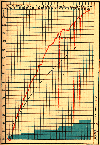
|
Fig. 92. Curve of an infant reared on mixed feeding.
|
|

|
Fig. 93. Mother had not enough milk. Child reared on
mixed feeding.
|
|
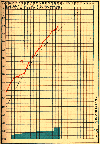
|
Fig. 94. Curve of an infant at first breast-fed by its
mother, who had plenty of milk. As she had to go out to
work, mixed feeding was practised.
|
|
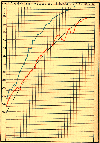
|
Fig. 95. Twins (blue, boy; red, girl) reared on mixed
feeding, as the mother had not enough milk adequately to
nourish both.
|
|

|
Fig. 96. Twins. Mixed feeding (blue, boy; red, girl).
|
|
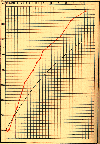
|
Fig. 97. Artificial feeding. Mother had no milk, and a
wet-nurse could not be obtained.
|
|
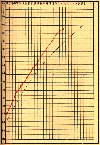
|
Fig. 98. Congenital syphilis. Mother had no milk.
Artificial feeding.
|
|
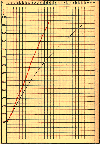
|
Fig. 99. Syphilis in the parents. Mother had not enough
milk. Artificial feeding.
|
|
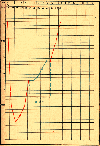
|
Fig. 100. Effect on an infant's weight of feeding with
diluted milk.
|
|

|
Fig. 101. Artificial feeding, first with diluted (blue)
and then with undiluted milk (red). The blue part of the
curve persistently falls away from the normal line which the
red part rapidly approaches.
|
|
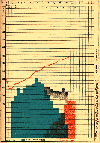
|
Fig. 102. Hare-lip. Artificial feeding. Of asses' milk
750 grams were required per day, of cows' milk 450. The
curve steadily rose.
|
|

|
Fig. 103. Digestive troubles arising from an excessive
allowance of milk.
|
|

|
Fig. 104. Digestive troubles due to over-feeding.
|
Return to The Nursling Contents Page
Created 2/19/97 / Last modified 2/19/97
Copyright © 1998 Neonatology on the Web / webmaster@neonatology.net












